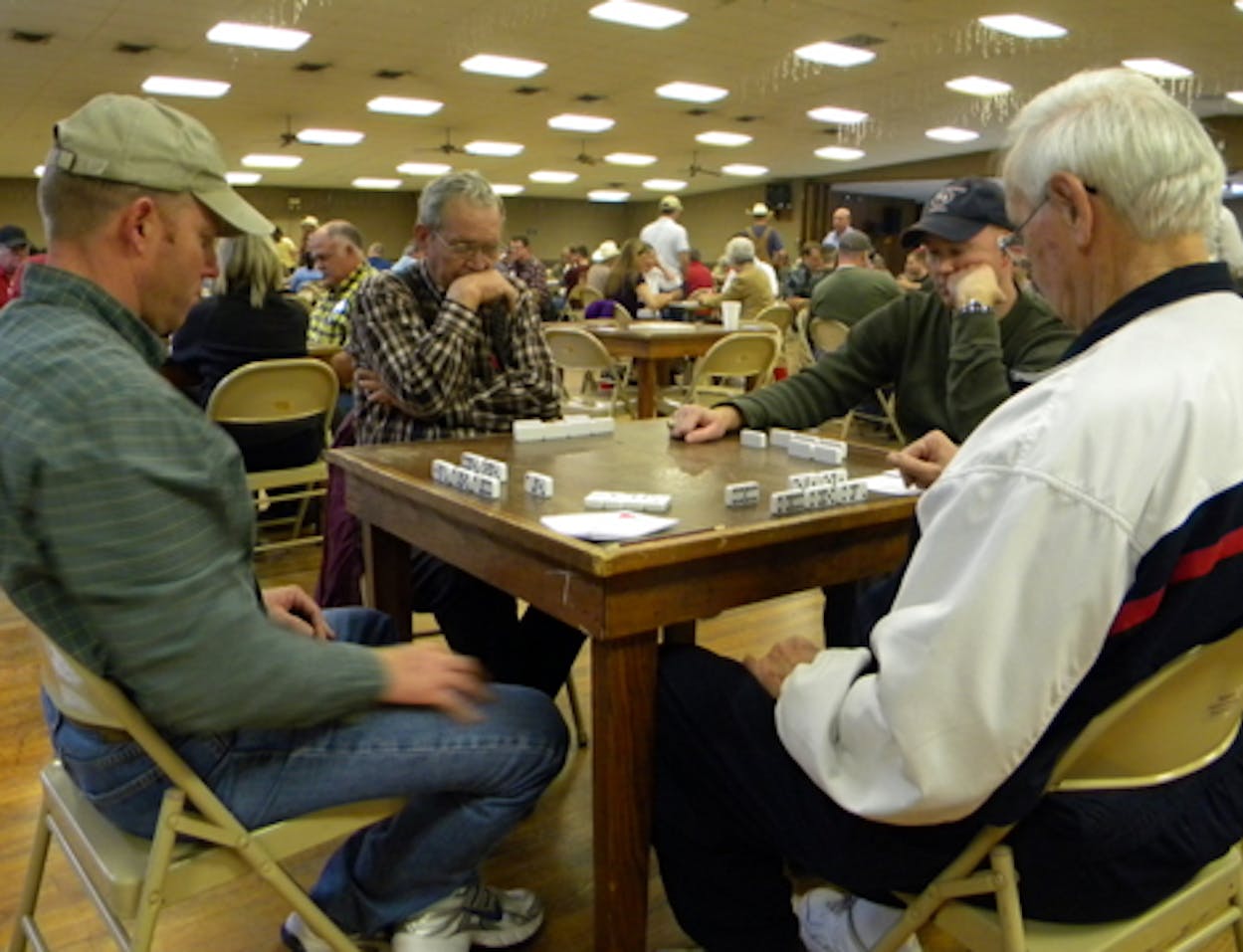On a rainy night last January, Darrell Morgan, the tournament coordinator for the Austin 42 Club, sat at a table in the wood-paneled Local Pub & Patio waiting for seven small, square tables to fill up. In only five weeks, players would be testing their luck and strategy at the Texas State Championship 42 Domino Tournament, scheduled for March 3 in Hallettsville, and he was expecting several Austin teams to come and practice at that night’s mini-tournament.
Like many who began taking their seats at the tables, Morgan learned the domino game called 42 as a child, but upon joining the Austin 42 club he quickly realized that this group played much tougher than his family had. Morgan, who seems to be a straitlaced person, minces no words in describing his first experience in the league: “I got my butt whipped.”
No doubt this would happen to some newcomer on this night. By 7:15, every attendant had paid a $5 entry fee and Morgan, who was very tall and lanky and wearing a burnt orange fleece, raised his voice over the conversations and blaring jukebox. “Let’s get started,” he said. A clinking of dominoes commenced.
Similar scenes of game night have been taking place in halls around Texas since the late 19th century, when two boys west of Fort Worth exploited a loophole in the Baptist bylaws that permitted dominoes, but not cards, by inventing a “card” game using dominoes. Using rules similar to bridge or spades, players must bid their hands and catch tricks or set their opponents. (The name of the game comes from the total number of points available in a hand.)
Hundreds of small groups, mostly composed of retirees, now gather weekly or monthly for informal games and tournaments. Last year, the unofficial “national game of Texas” received a more formal designation when the legislature named it “the official state domino game.”
Despite the recognition, however, the game is dying off as its players age. There are a few cities in Texas where this is not the case, one of which is Austin, home to the largest club in the state.
Aaron Kuntschik, the club’s 39-year-old director, says the group formed in the spring of 2005.
“In six years we’ve had a little more than two hundred people sign up,” he said. “Of those, we usually have sixty or seventy active members in the league.”
Besides mini-tournaments once a month, the club offers spring and fall leagues, each ten weeks long, plus playoffs and a six-week summer fun league.
During a break in play at the mini-tournament, Mike Sobin, a 32-year-old in a red T-shirt and backward baseball cap, leaned against a pool table and explained how he helped create the club.
“A friend taught a few of us how to play, then we taught other people, and within a year we had a little league of eight,” Sobin said.
In 2006, his club combined with another 42 club that had risen independently at a bar across town, bringing the total number of teams to sixteen.
Partly because Sobin and his friends who started the group were in their twenties, the club that has formed is much younger than other 42 groups in Texas. Roughly one quarter of players are under thirty, half are between their thirties and fifties, and one quarter are in their sixties or beyond.
Their knowledge of the game varies—the club teaches newcomers tournament etiquette: no drinks on the tables, keep your hands on your lap, and don’t touch other people’s dominoes.
Their backgrounds often differ, which means controversial subjects could divide a table, but the players can be quickly united by a joke or a jukebox hit.
On this night some political sparring at one table ended with participants mouthing lyrics and bobbing their heads to Scorpion’s “Rock You Like a Hurricane.”
“The fun thing about 42,” said Jody Badum, the president of the National 42 Players Association, “is that I know everything about this game and you may just know the fundamentals, but you still have a chance to win.”
Before anyone within earshot could feel comforted, however, he added with a shrug and a smile, “Usually I beat the crap out of people and don’t give them a breath of fresh air. Why give them hope?”
The more devoted members of the club often travel to tournaments in cities including Giddings, Hillsboro, Nacogdoches, and Fredericksburg.
But the most anticipated sojourn is surely Hallettsville, which is why the weeks after the mini-tournament would take on some importance. The three-decade-old event in Hallettsville is the state’s largest, bringing together roughly sixty to one hundred teams as opposed to a more typical twenty to thirty teams. In large part because of the level of competition, participants play for prestige more than the $200 payout.
“We do practice,” Kuntschik said. “I’m in practice mode with my partner right now. I’ve played Hallettsville with him the last couple of years, and one of our goals is to win that.”
With Austin groups placing second, third, and fourth in Hallettsville in recent years, the teams are considered increasingly formidable.
“Before they didn’t mind us coming; we weren’t taking home any prize money,” Kuntschik said. “Now we seem to be winning more of the trophies.”









